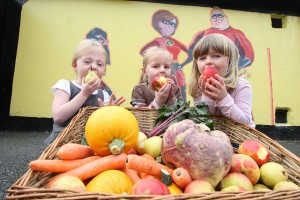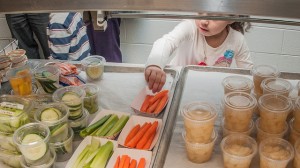This post focuses on the impact of good nutrition on behavior and learning. After spending only an hour researching the topic I found hundreds of studies and articles focused on the positive connections between well-fed students and their abilities to focus, self regulate and succeed in school. Given the volumes of evidence, it is astounding to me that most students are still given foods that are high in simple carbohydrates and filled with chemicals.
Well, maybe not astounding. It makes sense. Often these foods are more accessible, more familiar to children’s (and adult) palates, embedded in our cultural taste buds, and cheaper. They are also advertised more than healthy foods and they are more addictive, so once you have a donut or Cheetos treat for a snack, you want another the next day not just because it is the routine but because both your brain receptors and your taste buds are primed (for the glucose rush). I have also heard many times that if we give students something nutritious they won’t eat it, they will then act out more, and our jobs will be harder.
In the article “Hungry Kids: The Solvable Crisis” in the May 2013 publication of Educational Leadership, Christy Felling states one-fifth of America’s children (16 million) struggle with hunger. She shares a 2012 study by Share Our Strength that found that overwhelmingly the 1,000 K-8 public teachers surveyed said childhood hunger continues to be a “serious obstacle to learning.” Further, breakfast seems to play a crucial role in student achievement. 95% said eating breakfast increased concentration, 89% said it increased overall academic performance, and 73% said it helped improve classroom behaviors. Many of these children do eat food, but the food does not provide enough nutrition for the brain and body.Image may be NSFW.
Clik here to view.
However, feeding young people healthy food is a complicated endeavor. Not only does it involve finding the resources to make and buy healthier foods, but it means changing mindsets of students, parents and the professionals who work with them. Here are just a few examples of research findings related to nutrition and learning discussed by Eric Jensen in Teaching With the Brain in Mind (2nd edition, 2005):
1. The brain needs a variety of nutrients to be able to function optimally. To focus, remember and regulate our emotions we need protein, unsaturated fats, complex carbohydrates and sugars (in grains, fruits and vegetables), as well as a host of trace elements such as iron, potassium, and selenium.
2. Low blood sugar because of lack of complex carbohydrates negatively affects the hippocampus which plays a central role in learning.
3. Sufficient protein is essential because growing bodies need protein more than any other nutrient (besides clean water) and proteins are synthesized into dopamine and norepinephrine which are essential chemicals for quick reaction time, thinking and working memory.
4. Vitamins A, B, C, and E and fatty acids (primarily omega 3’s) are essential for vision and cell maintenance. These are NOT found in white bread, pasta, sugar, and Tator Tots.
There are also hundreds of studies focusing on particular low-nutrient foods that negatively affect learning. One says that students deficient in iron were twice as likely to score lower on math tests (Louwmann et al, 2000). And Dr. Daniel Amen, an ADHD expert, writes extensively about the positive effects of quality protein on calming impulsivity and distractibility for students with certain types of ADD.
In addition, poor nutrition increases stress on our physical and psychological systems, and actually can contribute to acting out. Carla Hannaford in Smart Moves: Why Learning is Not All in Your Head says that without sufficient water, amino acids, complex carbohydrates and sugars, and good fats, our frontal lobes do not function properly. We are unable to self talk, control our own behaviors, plan ahead, speak articulately, display integrated motor skills, or think before acting.
Behaviors can be transformed by a steady stream of good calories and fresh water.
I want to share one wonderful example of how a school in the Midwest improved learning and behavior outcomes by changing what students ate during the school day. Before the changes in the lunch program in 2002, the students at Central Alternative High School in Appleton, Wisconsin had one of the highest drop out and expulsion, drug use, weapons possession, and suicide rates in the state. Since the addition of healthier foods including a salad bar option every day, the Principal LuAnn Coenen said the numbers in every category have been ‘zero.’ A teacher participant at the high school stated, “Nutrition for students should be part of the general operating budget. We’re concerned about everything else. We’re concerned about new band uniforms. We’re concerned about the football team. We’re concerned about textbooks. Why not be concerned about nutrition? That seems to me to be the basis in many cases for a positive learning environment.” (See “A different kind of school lunch” article: http://www.feingold.org/PF/
Image may be NSFW.
Clik here to view. What can we do? We can start by researching (and eating differently) ourselves. We can introduce students to new foods slowly. One staff member I work with said let’s have monthly taste tests where students are introduced to new foods. Give choices but keep them healthy. Commit to finding resources to support better meals and better food purchases. Give students water bottles or water breaks each day. Go on a healthy-foods-store field trip. Get rid of vending machines. Research healthy alternatives students might like: cheese and crackers, yogurt smoothies, chili, tuna salad, pea soup, carrots and dip, raisins and nuts, fresh fruit, whole wheat penne and tomato sauce, cut vegetables, energy bars, rice cakes, etc. Let students help make or buy snacks so they have a “steak” in what they eat. Provide parents with information on food programs, good nutrition and its connection to learning, and the importance of a good breakfast. Host a parents’ potluck night out to share in eating healthy foods and snack choices.
What can we do? We can start by researching (and eating differently) ourselves. We can introduce students to new foods slowly. One staff member I work with said let’s have monthly taste tests where students are introduced to new foods. Give choices but keep them healthy. Commit to finding resources to support better meals and better food purchases. Give students water bottles or water breaks each day. Go on a healthy-foods-store field trip. Get rid of vending machines. Research healthy alternatives students might like: cheese and crackers, yogurt smoothies, chili, tuna salad, pea soup, carrots and dip, raisins and nuts, fresh fruit, whole wheat penne and tomato sauce, cut vegetables, energy bars, rice cakes, etc. Let students help make or buy snacks so they have a “steak” in what they eat. Provide parents with information on food programs, good nutrition and its connection to learning, and the importance of a good breakfast. Host a parents’ potluck night out to share in eating healthy foods and snack choices.
But begin somewhere, because the link between good nutrition and learning is a “No Brainer.”
Photo Credits
U.S. Department of Agriculture
Food Ethics Council
The post The Impact of Nutrition on Learning and Behavior: A No Brainer appeared first on National Institute for Student-Centered Education.